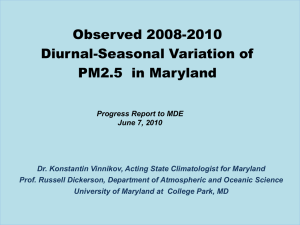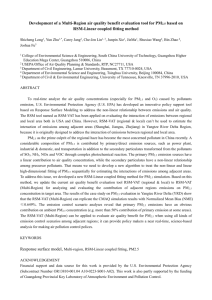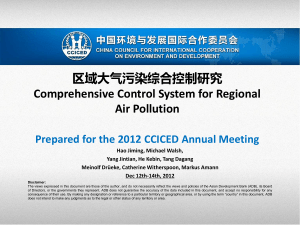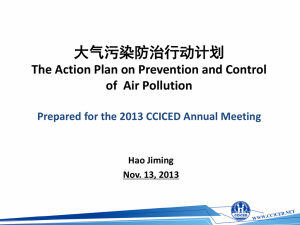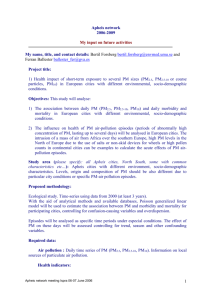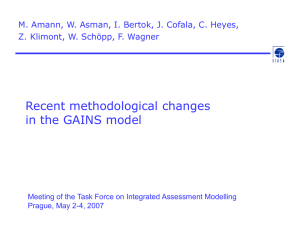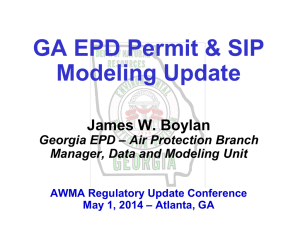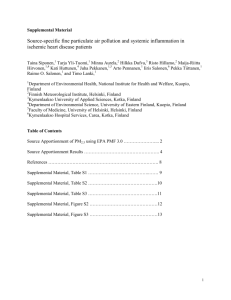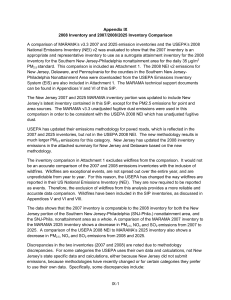Vertical variation of wind vector and PM 2.5 concentration
advertisement
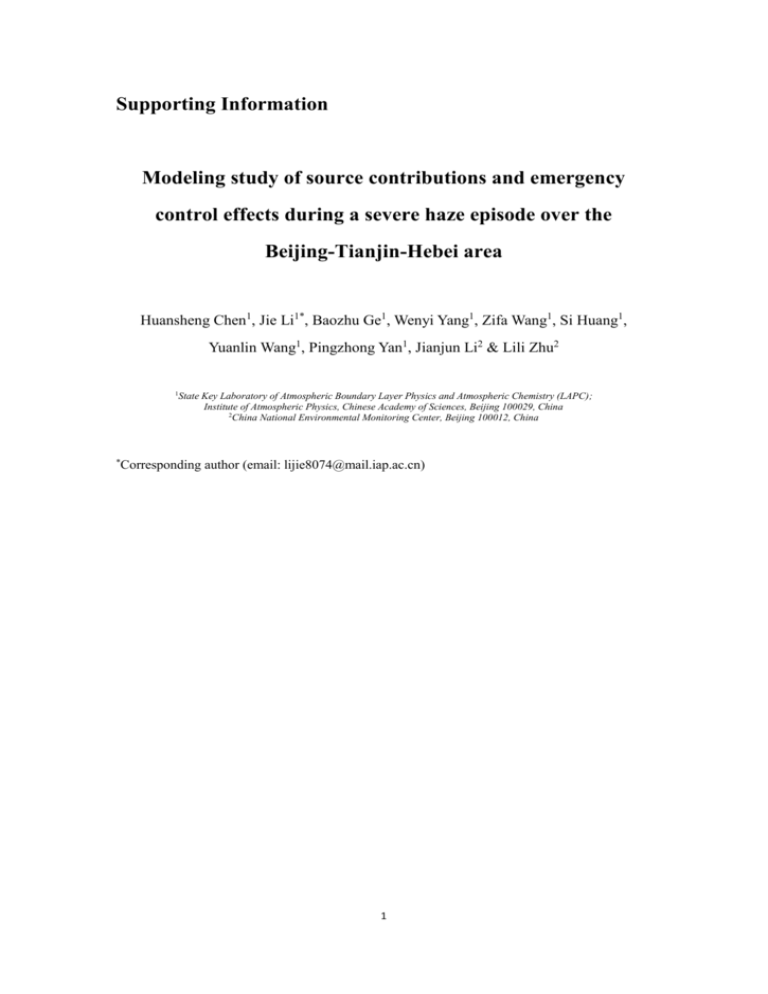
Supporting Information
Modeling study of source contributions and emergency
control effects during a severe haze episode over the
Beijing-Tianjin-Hebei area
Huansheng Chen1, Jie Li1*, Baozhu Ge1, Wenyi Yang1, Zifa Wang1, Si Huang1,
Yuanlin Wang1, Pingzhong Yan1, Jianjun Li2 & Lili Zhu2
1
State Key Laboratory of Atmospheric Boundary Layer Physics and Atmospheric Chemistry (LAPC);
Institute of Atmospheric Physics, Chinese Academy of Sciences, Beijing 100029, China
2
China National Environmental Monitoring Center, Beijing 100012, China
*Corresponding
author (email: lijie8074@mail.iap.ac.cn)
1
Air quality evolution in the BTH area
Figure S1 shows the time variation of the air quality index (AQI) for Beijing (BJ),
Tianjin (TJ), and various cities from the Hebei (HB) Province during the study period.
On February 19, severe haze pollution began to appear in BTH, lasting for about eight
days. A maximum AQI of 500 appeared in Shijiazhuang (SJZ) and Baoding (BD),
while the pollution levels in TJ and Chengde (CD) were relatively low. The study
period was divided into two episodes: February 19–26 (Case I) and February 27–28
(Case II), which represented the polluted and non-polluted periods, respectively.
Figure S1 Time variation of the air quality index (AQI) for Beijing (BJ), Tianjin (TJ), Chengde (CD),
Tangshan (TS), Baoding (BD), Shijiazhuang (SJZ), Hengshui (HS), and Handan (HD). Cases I and II
represent the polluted and non-polluted periods, respectively. An AQI above 200 was considered an
indicator of heavy pollution
Anthropogenic emissions by sector in the BTH area
Figure S2 shows the total anthropogenic emissions of SO2, NOx, and PM2.5 and
the percentage contributions from each sector for BJ, TJ, and HB. The emissions of
SO2, NOx, and PM2.5 in BJ and TJ were comparable, while the emissions in HB were
8.7, 5.5, and 6.2 times higher than for BJ. In terms of sectors, industry contributed
significantly (over 30%) to the emissions of SO2, NOx, and PM2.5. Domestic sources
mainly emitted PM2.5 (over 40%) and SO2 (over 19%), while power plants mainly
2
emitted SO2 (over 5%) and NOx (over 20%). Transportation only contributed
significantly to NOx emission (22–30%). The sector contributions in TJ and HB were
similar, while in BJ the contribution of power plants was relatively small and the
contribution of transportation was relatively large. Overall, industry and domestic
sources were the main sources of PM2.5, while transportation and power plants had
similar contributions.
Figure S2 Monthly emissions of SO2, NOx, and PM2.5 in the Beijing-Tianjin-Hebei (BTH) area
and percentage contribution from each sector
Statistical parameters of model performance
R (Correlation Coefficient):
1
𝑁
̅
̅ 2 2
̅
̅ 2 𝑁
𝑅 = {∑𝑁
𝑖=1(𝑀𝑖 − 𝑀)(𝑂𝑖 − 𝑂 )}/{∑𝑖=1(𝑀𝑖 − 𝑀) ∑𝑖=1(𝑂𝑖 − 𝑂 ) }
MB (Mean Bias):
MB
1
N
N
(M
i 1
i
Oi ) M O
(A2)
N
N
i 1
i 1
NMB (Normalized Mean Bias): NMB [ (M i Oi )] / Oi (
1
RMSE (Root Mean Square Error): RMSE
N
FAC (Fraction of data that satisfies 0.5 ≤
𝑀𝑖
𝑂𝑖
3
(A1)
M
1)
O
(A3)
1
2
( M i Oi ) 2
i 1
N
≤ 2): FAC= NV/N
(A4)
(A5)
N: number of modeled and observed data pairs
NV: number of modeled and observed data pairs that predict between 0.5 and 2
times of observation
𝑀𝑖 : modeled concentration at time i
̅ : averaged modeled concentration
𝑀
𝑂𝑖 : observed concentration at time i
𝑂̅: averaged observed concentration
Model verification of meteorological parameters
Figure S3 Comparison between the simulated and observed surface meteorological parameters
(temperature, relative humidity, wind speed and direction) in (a) Beijing and (b) Tianjin
Figure S4 Comparison between the simulated and observed surface meteorological parameters
(temperature, relative humidity, wind speed and direction) in (a) Baoding and (b) Shijiazhuang
4
Model verification of SO2 and NO2
Figure S5 Comparison between the simulated and observed hourly concentrations of SO2 for
different sites
Figure S6 Comparison between the simulated and observed hourly concentrations of NO2 for
different sites
5
Vertical variation of wind vector and PM2.5 concentration
Figure S7 Time variation of the vertical profile of simulated wind vector (top) and PM2.5
concentration (bottom) in Beijing on February 18-28, 2014
Figure S8 Time variation of the vertical profile of simulated wind vector (top) and PM2.5
concentration (bottom) in Tangshan on February 18-28, 2014
6
Spatial distribution of terrain height, PM2.5 emissions and concentrations
Figure S9 Spatial distribution of (a) primary PM2.5 emission rates (µg m-2 s-1), (b) terrain height
(km), and (c) simulated mean surface PM2.5 concentrations over the BTH area
during February 19-26, 2014
7
Vertical variation of source contributions from different emission sectors
Figure S10 Vertical variation of PM2.5 concentrations (µg m-3) and percentage contribution (%) of
the different emission sectors in BJ (a), EHB (b), NHB (c), and SHB (d)
during the polluted period (Case I)
8
